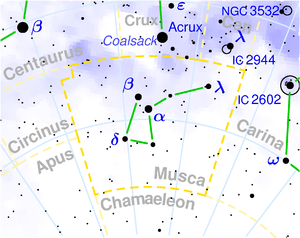 A small constellation of the southern sky lying between the Chameleon and the Crux in the Milky Way, not visible from our latitudes. The constellation of the Musca is quite a striking feature, although apart from α Muscae its stars do not exceed third magnitude. The star λ Muscae is white and together with μ Muscae, which is red, forms a contrasting pair in the binocular. Of the deep-sky objects in the constellation, two globular clusters that are visible to the binocular attract attention: NGC 4372 and NGC 4833, as well as a small portion of the dark Coal Sack Nebula that extends in from the neighboring Crux. To the northwest of NGC 4372, there is again an interestingly curled dark filament a little bit of a degree in size - the Dark Doodad Nebula.
A small constellation of the southern sky lying between the Chameleon and the Crux in the Milky Way, not visible from our latitudes. The constellation of the Musca is quite a striking feature, although apart from α Muscae its stars do not exceed third magnitude. The star λ Muscae is white and together with μ Muscae, which is red, forms a contrasting pair in the binocular. Of the deep-sky objects in the constellation, two globular clusters that are visible to the binocular attract attention: NGC 4372 and NGC 4833, as well as a small portion of the dark Coal Sack Nebula that extends in from the neighboring Crux. To the northwest of NGC 4372, there is again an interestingly curled dark filament a little bit of a degree in size - the Dark Doodad Nebula.
α Mus - The brightest star of the constellation, which reaches a magnitude of 2.94. At a distance of 29.6", it has a very faint companion with a magnitude of 12.8. It is located 306 light-years away from us.
β Mus - The elegant double star is composed of components of 4th magnitude orbiting around a common center of gravity once every 383 years. The current separation of the components is 1.6 arcseconds, which is a good test for a 100 mm telescope. The system is located 520 light-years away from us.
θ Mus - A binary star, whose components with magnitudes of 5.6 and 7.6 can be separated with a small telescope. The brighter star is a luminous blue supergiant, while its companion is an example of a Wolf-Rayet star - a hot star that has lost its outer layers.
N 1991 - In 1991, a nova erupted on the western edge of the constellation, designated as N 1991, which briefly became one of the brightest sources of X-ray radiation in the sky. It is believed to be a close binary star, with one component orbiting around a black hole, which can trigger processes leading to intense X-ray emission.
NGC 4833
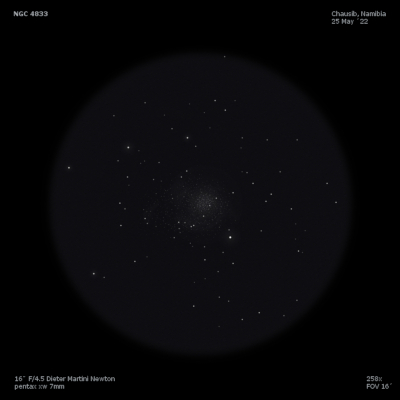
10x30mm Canon IS (3/27/19 - Tasmania): moderately bright and large globular, round. Contains a brighter star on the north edge.
Nicolas-Louis de Lacaille discovered NGC 4833 = Lac I-4 = D 164 = h3444 in 1751-1752 with a 1/2-inch telescope at 8x during his expedition to the Cape of Good Hope. He included it in his 1755 catalogue as I-4, classifying it as a nebula, and noting it resembled "a small faint comet."
James Dunlop observed this globular with his 9-inch f/12 speculum reflector on 29 Apr 1826 (second night he recorded objects) from Parramatta, New South Wales and described "a pretty bright round nebula, about 4' diameter, moderately condensed to the centre. This, with the sweeping power, has the appearance of a globe of numerous matter with very small stars in the north following margin. But with a power sufficient to resolve it, the globular appearance vanishes in a very considerable degree; and the brightest and most condensed part is to the preceding side of the centre, with the stars considerably scattered on the N.f. side. Resolvable into stars of mixt small magnitudes. A small nebula precedes this." He observed the cluster on 5 nights.
John Herschel first recorded "globular cluster, B, L, R, gbM, stars 14th mag, and one 7th mag north-preceding the centre; a fine object." On a second sweep he logged "globular cluster, pB, L, p rich, at first gradually, then vspmbM; diameter of the bright part 3', of the loose stars 10'; stars 12..16th mag, and one large one 7th mag, 3' or 4' north of the centre."
400/500mm - 18" (7/10/02 - Magellan Observatory, Australia): This was a surprising find for a little known globular! At 171x, it appeared as a bright, fairly large globular of low concentration class. The loose halo was highly resolved and numerous stars were splashed across the brighter core. Many of the stars formed large loops and chains. A single bright star (mag 8.7 SAO 256996) is superimposed on the northern side of the halo. The core spans roughly 3', while outliers increase the overall halo to at least 10' [John Herschel gave similar dimensions]. Located 42' NNW of mag 3.6 Delta Muscae and 3° NE of gc NGC 4372 which is a comparable cluster.
600/800mm - 24" (4/12/08 - Magellan Observatory, Australia): at 260x this is a gorgeous highly resolved globular with several hundred stars splashed across the core and within a loose, well-resolved halo. The center is strongly compressed with a very bright 3' core surrounded by a large halo, roughly 10' in diameter. Beyond 5' or 6' out from the center the halo becomes scraggly but continues to extend out in loops and strings. A brighter mag 8.7 star is superimposed in the halo, 2.5' N of center.
Notes by Steve Gottlieb
NGC 4372
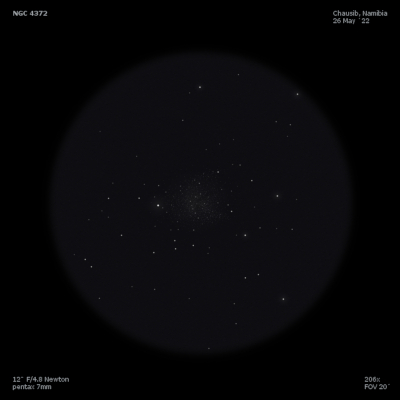
10x30mm Canon IS (3/28/19 - Tasmania): faint, low surface brightness glow with no core. Attached to the south of a mag 6.6 star that is close to the end of the "Dark Doodad".
James Dunlop discovered NGC 4372 = D 67 = h3390 on 30 Apr 1826 using his 9-inch f/12 speculum reflector from Parramatta, NSW. He described "a star of the 6th magnitude, with a beautiful well-defined milky ray proceeding from it south following; the ray is conical, and the star appears in the point of the cone, and the broad or south following extremity is circular, or rounded off. The ray is about 7' in length, and nearly 2' in breadth at the broadest part, near the southern extremity. With the sweeping power this appears like a star with a very faint milky ray south following, the ray gradually spreading in breadth from the star, and rounded off at the broader end. But with a higher power it is not a star with a ray, but a very faint nebula, and the star is not involved or connected with it: I should call it a very faint nebula of a long oval shape, the smaller end towards the star; this is easily resolvable into extremely minute points or stars, but I cannot discover the slightest indications of attraction or condensation towards any part of it. I certainly had not the least suspicion of this object being resolvable when I discovered it with the sweeping power, nor even when I examined it a second time; it is a beautiful object, of a uniform faint light." Dunlop's position is 24' too far WNW (a fairly large error), but the mag 6.6 star near the NW edge clinches the identification. His sketch is shown in Fig. 2 of his catalogue.
John Herschel described it (1 Apr 1835) as "a globular cluster, very faint; large; very gradually brighter in the middle; 6' diameter; resolved into stars of 15th magnitude; rich in stars; a delicate and faint object; has a star 45 N.p., distance 5' from centre. Almost perfectly insulated in a very large space almost entirely devoid of stars, being the smaller and southern lacuna below the great 'coal sack'."
400/500mm - 18" (7/6/05 - Magellan Observatory, Australia): at 171x, this large, bright globular was an impressive object and beautifully resolved into 150-200 stars mag 13 and fainter, within a 13'-14' diameter. The unresolved background glow was relatively faint for such a well-resolved globular. The large 4' core was only slightly brighter and there was no nucleus (class 12 concentration), although a close pair of brighter mag 12.5 stars is near the center. Scores of stars appeared linked in chains and loops, particularly in the outer halo, which is quite irregular and ragged. Mag 6.6 HD 107947 lies 5.5' NW of center at the edge of the halo and provided a striking contrast although it detracted somewhat from viewing. A dust lane appeared to pierce the cluster on the north side for a few arc minutes (east of the bright star) and this dark intrusion may be an extension of the "Dark Doodad" (see notes).
18" (7/7/02 - Magellan Observatory, Australia): at 228x, this large, loose globular was well-resolved into ~100 stars mag 12-15 with a 12' diameter. The roundish core is ~4' in size with many faint stars sprinkled across the core. The halo is elongated and irregular in shape. A starless dark lane appears to wind into the cluster towards the core from the NW side angling roughly NW-SE (later verified on the DSS). A mag 6.8 star lies 5' NW of the core and interferes with viewing! Located 44' SW of mag 3.8 Gamma Muscae.
600/800mm - 24" (4/12/08 - Magellan Observatory, Australia): at 260x, NGC 4372 is a highly-resolved, low-concentration class globular. A mag 6.6 star just 5.5' NW of center was a bit distracting but scores of stars were resolved over the 4' core, appearing to criss-cross the center in numerous lanes. The outer halo was very large, nearly 15' in diameter, and resolved into a couple of hundred stars. Except for the brighter and denser core, this globular appeared similar to a very large, fully resolved open cluster.
Notes by Steve Gottlieb
NGC 4815
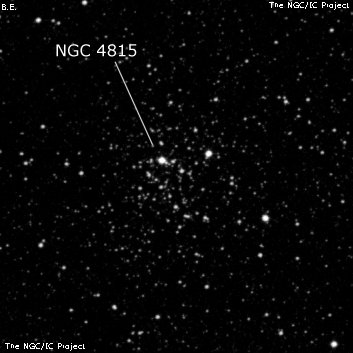
John Herschel discovered NGC 4815 = h3443 on 13 Mar 1834 and recorded "Class VI, p rich, irregular fig, gbM, 3', stars vS, comparatively insulated; has two bright stars 8-9th mag and 9-10th mag." On a second observation he described a "Cluster, R, pS, resolved; irreg; gbM, 3', stars 13..18th mag." Innes was unable to resolve the cluster in 1901 using a 7-inch refractor from the Cape of Good Hope (MN, 62, 469).
300/350mm - 13.1" (2/20/04 - Costa Rica): at 105x, two mag 10 stars are surrounded by a number of very faint stars within 3'. The cluster is superimposed on a fairly bright milky background of unresolved stars. A third mag 10 star is apparently outside the border off the SW edge. At 200x, the unresolved glow is most prominent at the following end and 12-15 mag 13 stars are sprinkled over the backround glow (the cluster was viewed at a very low elevation which probably detracted from the view). This reddened cluster is heavily obscured and is located just within the SE border of the Coalsack and barely over the border into Musca, 1.1 degrees ENE of the bright double star Theta Muscae (5.9/7.7 at 5"). The two brighter mag 10 stars (separated by 1.3') may be foreground stars and not actual cluster members.
Notes by Steve Gottlieb
NGC 5189
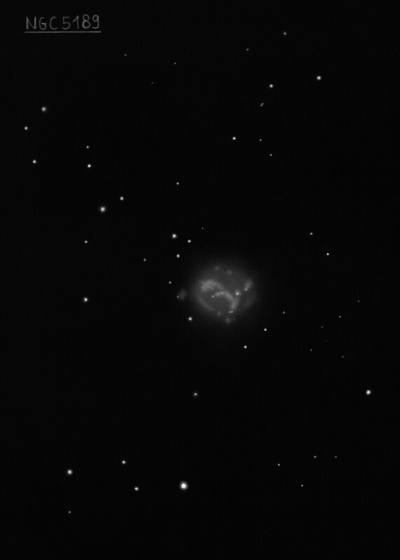
300/350mm - 12" (6/29/02 - Bargo, Australia): this is a bright, strange-looking PN with a complex bar structure dubbed the "Spiral Planetary". At 140x and UHC filter, it resembles a small barred spiral galaxy with prominent bar extending SW-NE with curved tips, ~1' in length embedded within a fainter, slightly elongated halo of ~2'x1.5'. A few stars are superimposed. At 186x, the "bar" is irregular and knotty with a bright knot at one end. A mag 11 star is at the SW end with a couple of faint stars on the opposite end. The faint 14th magnitude central star is just south of the bar. Located 6' NNW of mag 7.2 SAO 252366 in a rich star field in the NE corner of Musca. NGC 5189 was a fascinating sight!
400/500mm - 18" (7/6/05 - Magellan Observatory, Australia): the "Spiral Planetary" is certainly one of the most remarkably structured planetaries and would be famous if located in the northern hemisphere. At 128x using a UHC filter, a high surface brightness "bar" at least 1' in length, elongated SW-NE forms the main body of the planetary. The bar is slightly curved and has an irregular surface brightness. On the NE end is a prominent bright knot, roughly 6" in size. Nebulosity hooks below this knot, extending below the bar. Above the southwest end of the bar is the brightest superimposed star and a hook of nebulosity sweeps up to the northwest, wrapping above this star. The entire structure is encased in a much fainter oval envelope. A total of five stars are superimposed including a very close double that is just south of the southwest end of the bar and the 14th magnitude central star situated southeast of the center of the bar.
600/800mm - 24" (4/11/08 - Magellan Observatory, Australia): NGC 5189 was the last of 78 objects that I logged on 4/11/08 and the perfect end to a great evening with the 24". At 200x using a UHC this amazing planetary displayed an extremely complex morphology. Through the center is a bright, high surface brightness "bar" elongated WSW-ENE and ~1.5'x0.4' in size. This central feature has an uneven surface brightness with a mottled texture. A mag 12 star is superimposed just north of the west-southwest end and the fainter central star is just south of the bar. A close double star (~3.5") is superimposed just south of the west-southwest end. At this end a spiral extension hooks around counterclockwise to the north and passes through a faint star and ends at a very faint small knot just north of the superimposed star. A bright 10" knot is just south of the ENE end of the central "bar". Attached to this knot is another extension that sweeps towards the southwest, ending less than 1' S of center. About 50" E of the bright knot is another 10" knot that appears detached. A mag 12 star is ~50" SW of this knot, just outside the halo of the planetary. All of the brighter features are within a much fainter oval envelope, ~2.5'x2.0'.
Notes by Steve Gottlieb
NGC 4463
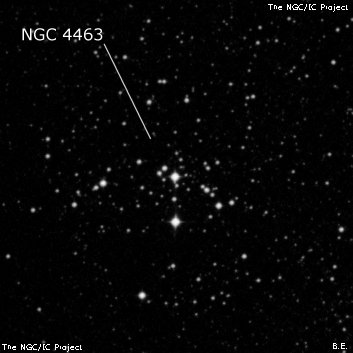
10x30mm Canon IS (3/27/19 - Tasmania): faint, small, round. A couple of close brighter stars were resolved near the center. Located on a line with Acrux and two other stars.
John Herschel discovered NGC 4463 = h3395 on 2 May 1835 and noted "cl VIII. class; poor; scattered. The northern of 2 stars 8m taken." His single position is good.
600/800mm - 24" (4/11/08 - Magellan Observatory, Australia): at 260x this is a fairly small but fairly rich group with two bright mag 8.5 stars (HD 108719 and PPM 779024) oriented N-S and separated by 1.3'. The cluster is fairly rich along a curving E-W string that passes through the northern of the two bright stars. Scattered outliers increase the size to perhaps 6'x3' and include up to 60 stars. This cluster is located just 1.7° SSE of Acrux on the SW edge of the Coalsack Nebula.
Notes by Steve Gottlieb
IC 4191
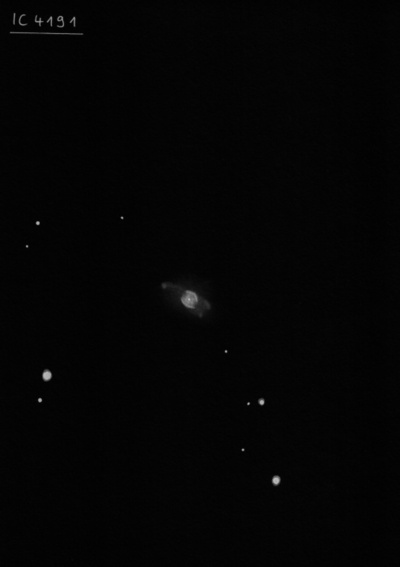
Williamina Fleming discovered IC 4191 = Fleming 107 in 1907 on a Harvard objective prism plate taken at the Arequipa station.
400/500mm - 18" (7/7/05 - Magellan Observatory, Australia): this bright, compact planetary was picked up by blinking with an OIII filter at 128x. IC 4191 forms the northern vertex of a small, distinctive triangle with a mag 10.6 star 1.1' SE and a slightly fainter mag 11 star 1.6' SSW. Excellent contrast gain of 2-3 magnitudes using the OIII filter. Without a filter, the planetary has that distinctive bluish color of planetaries and is slightly non-stellar with an extremely high surface brightness. At 293x a very small disc, perhaps 4"-5" in size is visible. The magnitude appears very similar to the mag 10.6 star 1.1' SE. Located 40' WNW of mag 4.8 Eta Muscae.
Notes by Steve Gottlieb
NGC 4071
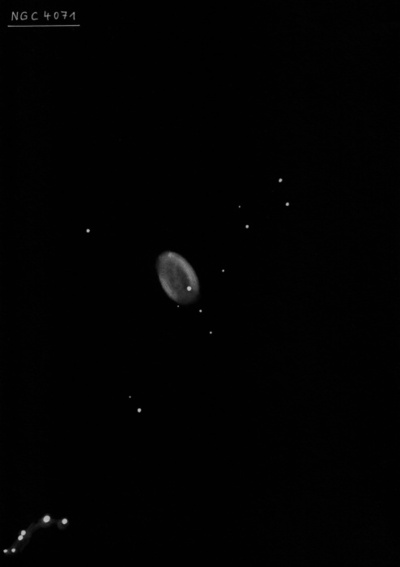
John Herschel discovered NGC 4071 = h3374 on 4 Mar 1835 and recorded "vF; R; 40"; has a vS star in centre; in a field of at least 80 or 90 stars." His position is accurate. The "vS star" he mentions might be the one on the southwest side.
400/500mm - 18" (7/6/05 - Magellan Observatory, Australia): I had a difficult time ferreting out this faint PN that is buried within a very rich Milky Way field. It was finally picked up at 76x (27 Panoptic) and OIII filter as a faint, round disc at least 40" in diameter. Removing the filter, a faint star was superimposed on the SW side of a low surface brightness glow. Also viewed unfiltered at 228x which showed the faint star and the disc more easily, though this is quite faint for NGC planetary. The best view was at 128x using an OIII filter, although NGC 4071 has a low-excitation level. The disc appeared fairly faint with subtle irregularities in surface brightness and was likely brighter along portions of the rim.
Notes by Steve Gottlieb